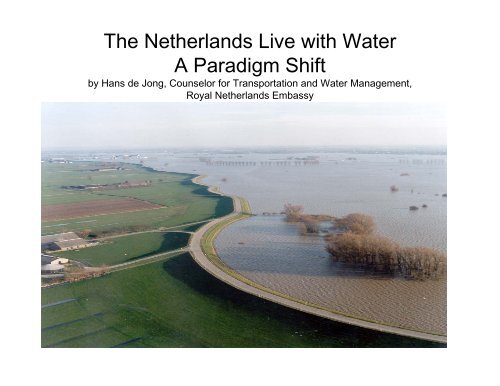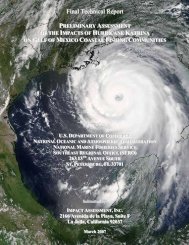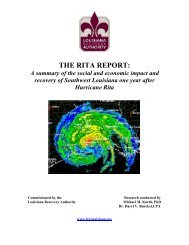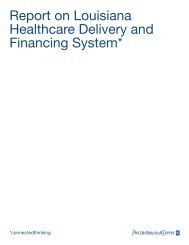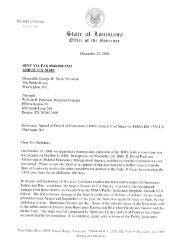The Netherlands Live with Water A Paradigm Shift
The Netherlands Live with Water A Paradigm Shift
The Netherlands Live with Water A Paradigm Shift
Create successful ePaper yourself
Turn your PDF publications into a flip-book with our unique Google optimized e-Paper software.
<strong>The</strong> <strong>Netherlands</strong> <strong>Live</strong> <strong>with</strong> <strong>Water</strong><br />
A <strong>Paradigm</strong> <strong>Shift</strong><br />
by Hans de Jong, Counselor for Transportation and <strong>Water</strong> Management,<br />
Royal <strong>Netherlands</strong> Embassy
Introduction<br />
• Flood protection is vital for the<br />
<strong>Netherlands</strong>:<br />
• 60% of our country is threatened by floods<br />
• 70% of our GNP (450 billion €) is threatened<br />
by floods<br />
• large cities like Amsterdam and Rotterdam<br />
are below sea level
Flood protection structures (I)<br />
• Approximately 2000 miles<br />
primary flood protection<br />
structures <strong>with</strong> legally<br />
prescribed safety standards<br />
• Largely (90%) managed by<br />
water boards; maintenance<br />
costs (150 million €/year) are<br />
raised by local taxation<br />
• Rijkswaterstaat manages<br />
large, complex and costly (100<br />
million €/year) structures<br />
• Secondary flood protection<br />
structures are the responsibility<br />
of provinces and water boards
Flood protection structures (II)<br />
Dunes<br />
Embankments<br />
Barriers
ural flooding ≠ urban flooding<br />
⇒<br />
rural flooding ≠ urban flooding<br />
rural flooding ≠ urban flooding<br />
⇒ evacuation not a local problem
Coastal management (I)<br />
• Coastal management policy is<br />
based on holding the<br />
coastline of 1990 and<br />
compensating for sand losses<br />
in the foreshore<br />
• Holding the line (in red) takes<br />
about 6 million m3 sand per<br />
year; compensating sand<br />
losses (in blue) in the<br />
foreshore about the same<br />
• Rijkswaterstaat carries out a<br />
coastal management program<br />
of 12 million m3 per year (43<br />
million €/year)<br />
• If sea level rise increases<br />
from 20 to 70 cm/century, the<br />
nourishment volume<br />
increases from 12 to 30<br />
million m3 per year
Coastal management (II)<br />
• Coastal management is<br />
based on beach and<br />
foreshore nourishment
Coastal embankments<br />
Typical crest level of 12-14 meters<br />
above MSL
Reinforcing coastal embankments<br />
• Continuous<br />
research and<br />
monitoring lead to<br />
new design codes<br />
• Example:<br />
revetments of<br />
coastal<br />
embankments are<br />
being<br />
reconstructed (due<br />
to more knowledge<br />
of hydraulic loads<br />
and structural<br />
behavior)
5, 6<br />
4<br />
3<br />
1 1<br />
2<br />
7<br />
8<br />
LESSONS<br />
FROM KATRINA<br />
1<br />
2<br />
3<br />
4<br />
lowering of groynes<br />
deepening low flow channel<br />
removing hydraulic obstacles<br />
lowering flood plains<br />
5<br />
6<br />
7<br />
8<br />
locally setting back dikes<br />
large-scale dike setback<br />
detention reservoir<br />
reduction lateral inflow<br />
Consider the entire safety chain
<strong>The</strong> <strong>Netherlands</strong> and Louisiana<br />
• Spatial planning is needed for integrated<br />
water management<br />
• Comparable spatial issues<br />
– Rebuilding flooded area’s is comparable<br />
<strong>with</strong> building in deep polders. Where to<br />
build, how to build Which safety level<br />
• Time span is different
An integrated approach<br />
NGO’s<br />
Government<br />
Knowledge<br />
institutes<br />
Private sector
Lobith<br />
1<br />
Köln<br />
2<br />
Mainz<br />
Worms<br />
3<br />
4<br />
5<br />
Rheinfelden
An integrated approach:<br />
How to get there<br />
• Policy<br />
– More space for retaining,<br />
storing and draining of water<br />
Examples are: room for rivers<br />
– <strong>Water</strong> (level) is leading for<br />
spatial planning
River management<br />
• Increasing design discharges<br />
would lead to another<br />
heightening and<br />
reinforcement of river<br />
embankments<br />
• Widening, deepening and<br />
smoothening the river bed<br />
accommodate increased<br />
discharges<br />
Project costs for the ministry are €2,4<br />
billion. Future management and<br />
maintenance is not yet estimated
Information and Research<br />
• Storm surge and flood<br />
warning services<br />
• Guidelines for design<br />
and maintenance of<br />
flood protection<br />
structures<br />
• Research program<br />
• Largely financed by<br />
the Ministry:<br />
approximately €10<br />
million/year
Finances in Flood Protection<br />
Source: <strong>Water</strong> in Beeld (2004)<br />
250<br />
million euro's<br />
Flood protection<br />
100%<br />
90%<br />
200<br />
80%<br />
70%<br />
150<br />
60%<br />
50%<br />
100<br />
40%<br />
30%<br />
50<br />
20%<br />
10%<br />
0<br />
Ministry<br />
<strong>Water</strong>boards<br />
0%<br />
Ministry<br />
<strong>Water</strong>boards<br />
Flood protection<br />
Other expenses
<strong>Water</strong> Boards
<strong>Water</strong> Boards<br />
• Reasons for mergers<br />
- • professionality (1953!)<br />
- • efficiency<br />
- • new tasks<br />
- • full dressed discussion partner
National Government<br />
Regional decentralised governments<br />
Territorial<br />
Province/municipality<br />
General tasks<br />
Functional<br />
<strong>Water</strong> board<br />
Limited tasks
National Government<br />
• Ministry of Transport, Public Works and <strong>Water</strong><br />
Management<br />
– Directorate General <strong>Water</strong><br />
– National policy on water management<br />
– Rijkswaterstaat<br />
– Rijkswaterstaat executes the national policy, maintains a knowledge<br />
infrastructure.<br />
– Rijkswaterstaat maintains water infrastructures<br />
• Other Ministries (internal affairs, land use and zoning<br />
etc.) are also involved in water management
Lessons we learned<br />
‣ Sustainable flood defenses ask for harmonization <strong>with</strong> naturel<br />
and the goods and services of water<br />
‣ Separation of water systems and reduced natural water<br />
exchange diminishes resilience for safety and ecology<br />
‣ <strong>The</strong> best solution would be an open system <strong>with</strong> large barriers<br />
and culverts not disturbing daily natural dynamics<br />
‣ It is wise to keep raising public awareness on our living <strong>with</strong><br />
water and flood risks.<br />
‣ It is wise to anticipate and innovate in order to prevent floods in<br />
future
Attention for Flood Protection is and will be a<br />
continuous process


